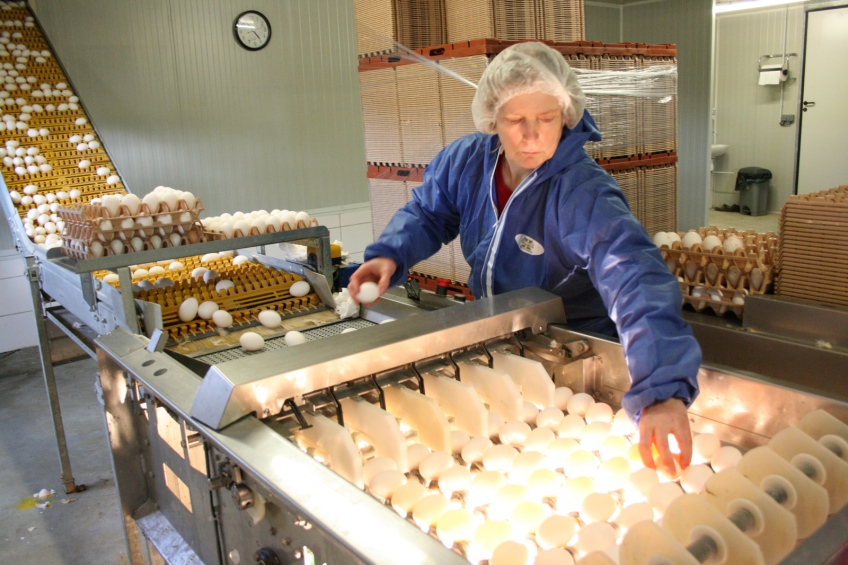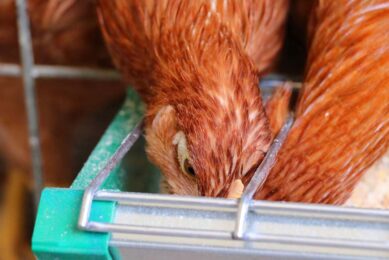France’s alternative eggs

Eggs and egg products in the ?alternative segment are in high demand in the Pays de Loire region of France. “More and more food products are marketed with an emphasis on their barn egg or free range egg ingredients,” says poultry farmer Regina Minier. She decided to produce barn eggs for the egg industry with an option to move to free range. “At this moment in time I chose for the aviary system, because that is easier to manage than free range, but the barn has a ?multifunctional design.”
While egg production has a long tradition in the Pay de Loire region of France, the Minier farm is of rather recent design. The family made a living from dairy farming for decades, before they decided to invest in a second branch of the farm. Seeing demand for eggs growing and after a good discussion with the local farmers co-operation, which helps in marketing the eggs, a new barn was commissioned. “We placed our first flock in 2010 and are now 65 weeks into our third flock,” says novice poultry farmer Minier. The evolvement of the Minier farm is exemplary for a number of colleagues in the area. In the last few years at least 18 poultry houses were constructed on relatively small scale family dairy or cattle farms. With the assistance of the co-op a more or less standard house design was adopted, with about 30,000 hens in an aviary system for barn egg or free range egg production. “It is a scale which is manageable for one person, in most cases the wife of the farmer.”
Co-op at the helm
When it comes to the supply of eggs, the farmers’ co-operation is at the helm; with long term planning and assisting with building new houses and more directly in giving mandatory guidelines how long a flock is kept in production. “Our current flock will be kept until 85 weeks, by choice of the co-operation.” That said, the way production is organised isn’t fully integrated, on the contrary. “We have a lot of room for implementing our own decisions. We own the building, we decide what brand of hen we want and pursue our own management strategies.” The co-operation is the trusted partner when it comes to feed and also when it comes to contacts for selling the end product. Minier: “The co-op has the contact with the egg processors, but in the end we as farmers have the contract, so there is some freedom of movement.”
Novogen
One of those choices was the switch from Lohmann LSL to NOVOgen White hens. Regina Minier: “When we started our business Lohmann was the most logical choice. After two flocks we wanted to experience what else was in the market. Novogen, part of Groupe Grimaud with it’s headquarters only a few miles away from the Minier’s farm, entered the layer market in 2008. Until then dominated by Lohmann, HyLine and ISA. We had no track record, so we want to get to know what hen suits us best. The Novogen hen will also get a second round to prove itself, just as the Lohmann hens got. After that, we will see how to go forward.”
Regina Minier is a woman, focused on details. Besides the day to day management of the flock, she is completely on top of the numbers produced by her flock. She keeps extensive records on all facets, making it possible to track performance against the expected values by the breeding company and gives the opportunity to compare one flock to the other. “To give the flock a good start I demanded from the hen rearing farm to follow a special lighting programme. Instead of a standard 12 hours at 17 weeks, I asked for only 11 hours of light in rearing at 18 weeks. Upping the light regime to 15 hours after placement in the production house I was able to keep the number of small eggs and floor eggs to a minimum and hope for better persistency later on. That makes the life of the farmer easier.” Minier continues: “In the end it is all about the numbers of course.” At 65 weeks of age the current flock is still performing well. “We have a laying rate of 90% and an average egg weight of 64.5 grams. The eggs are a little smaller than the eggs of the LSL’s, but we have less double eggs. Also, we are now in a phase in which we see a slight increase in second class eggs. However by adapting the speed of the conveyors and prevent shocks, we are able to limit the number of breakages.” Minier counts a 2.11 cumulative feed conversion at 64 weeks and never exceeds a daily feed intake of 120 grams, 118 grams being the economic optimum. “The aviary system installed by Jansen Poultry Equipment helps to prevent a negative impact on the hens energy balance. They can move efficiently through the system.”
By controlling and weighing faeces and feed distribution Minier finds that she can win 1 or 2 grams of feed intake a day. “The Novogen hens are calm and don’t waste much energy. They are really easy to manage.”
Keeping records on production is essential to get insight in to the profitability of the flock.
Eggs for industry
With more than 70% of all layers in France housed in enriched cages it would be logical that Minier would produce barn eggs for the table egg market and leave the normally less lucrative industry eggs to the cheapest production method. “Fortunately many food manufactures want to promote their products as being produced with more welfare friendly egg products. The huge demand for alternative eggs for the industry made me choose for industry production.” Recently she signed a new contract with the egg processor, a good deal, Minier stated. “We are satisfied with the deal. In exchange for a better price we agreed upon checking the eggs for cracks ourselves. We fabricated a lighting unit to be able to detect faulty eggs. This is a little more work, but we run the egg conveyors ourselves anyway, so its only marginal.”
With experience of just three flocks under her belt, Minier feels comfortable in what she does. “During the construction of the house in 2010 we kept all possibilities open. The house is in fact a free range barn, but with access to the pasture denied (wall openings are closed) and a higher stocking density, the house operates as a barn egg producing unit. Minier: “At this stage in time I think we should stick with the barn eggs. Free range eggs will market at an even higher price, but it comes at a price too. Density and thus production is lower and risks are higher. Barn egg production is easier to manage and I have experience with that now. I am still learning every day and think there is still more to get out of the flock. Switching to free range is a balance between ease of work and ease of mind and economics. I prefer ease at this point. That said, when the market demand changes dramatically, we will re-discuss the matter.”
The story of Novogen
Worldwide the market for layers is still growing, but in Europe it is at best stable. Up until some years ago, the market was divided into two parts, one in the hands of HyLine/Lohmann, one in the hands of ISA. “It was their customers demanding that there be more to choose from. That gave us the incentive to go to work with the genetic material we acquired already in the 1990s,” says Frederic Grimaud, President of Groupe Grimaud, the parent company of Novogen. Exploring opportunities in the layer market was a logical step for the multi-species breeding company. “We could use our global network, our R&D with transferable know-how and our existing customers trust. Our vision of the future is one of acceleration by creating additional leverage.”
Grimaud decided in 2008 to launch the layer programme under the Novogen brand. “Of course our potential customers were sceptical, but I am proud to say we have become a new credible player in the market. In the long term there is no reason not to reach a marketshare of 25%.” Frederic Grimaud continues: “Even if the European market is not growing, we are still able to change the playing field. ” With the recently signed alliance with Dutch commercial layer hatchery Verbeek, Novogen is able to supply large numbers of reared pullets to integrations wanting to have a go with Novogen, especially in European countries where there are no distributor networks in place. “Asia is a totally different market, the market is growing fast there, opening up new opportunities. And the US can use a breath of fresh air as well from market domination by Hy-Line.”
The Novogen owner says he wants to change the rules and is strengthened by customers putting trust in his company. “We are working hard to earn that trust. We know we have a really good layer, which can compete with the other players in the market. And because the genetic basis lies with the robust birds of French origin, its an easy manageable bird as well. All pure lines are sib-tested and put to the test in challenging conditions. Furthermore we are constantly working on feed efficiency, egg quality and making our birds ready for the non-beak trimming era. We have trust in our future, that is for sure.”
Join 31,000+ subscribers
Subscribe to our newsletter to stay updated about all the need-to-know content in the poultry sector, three times a week. Beheer
Beheer








 WP Admin
WP Admin  Bewerk bericht
Bewerk bericht